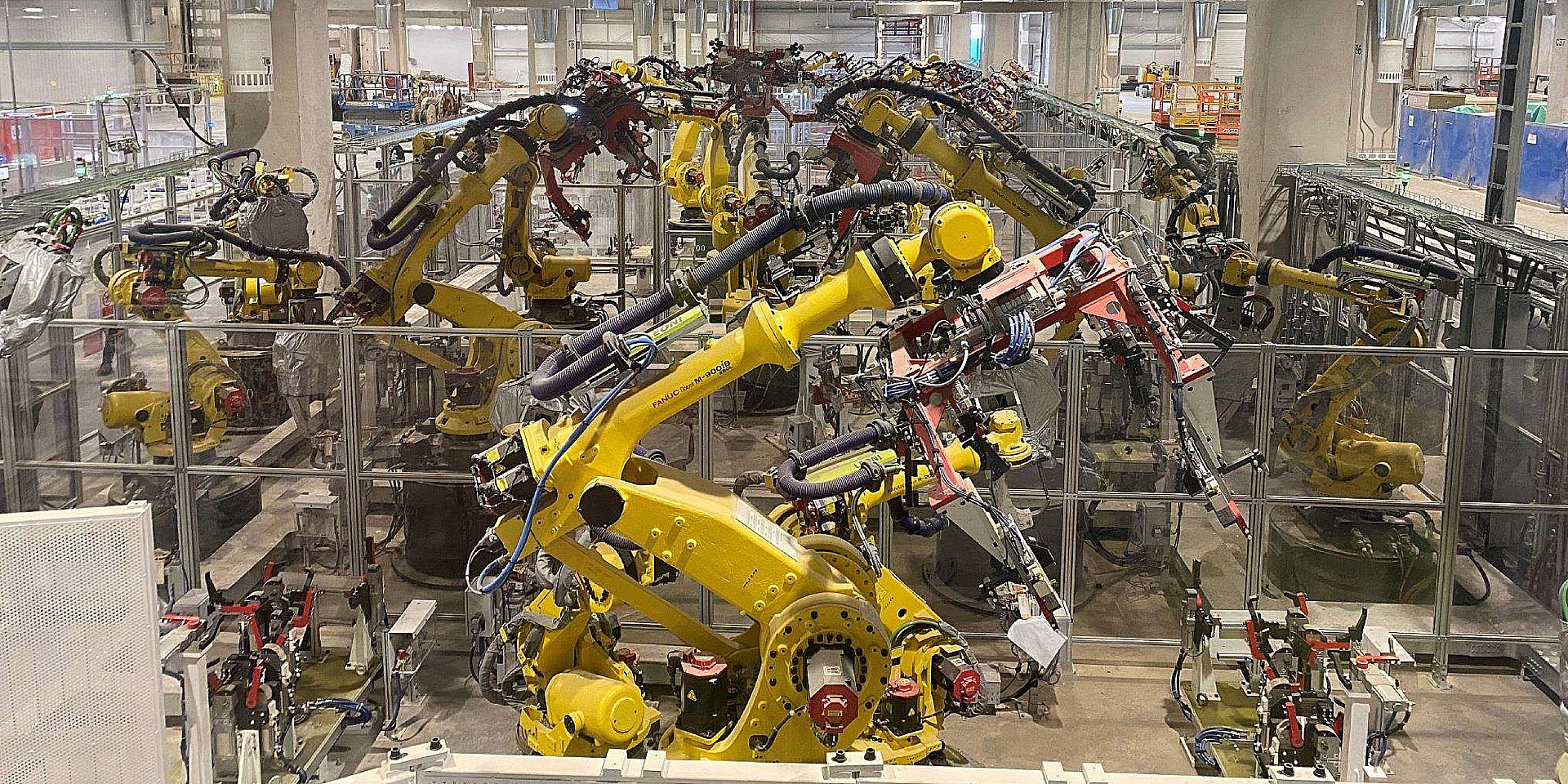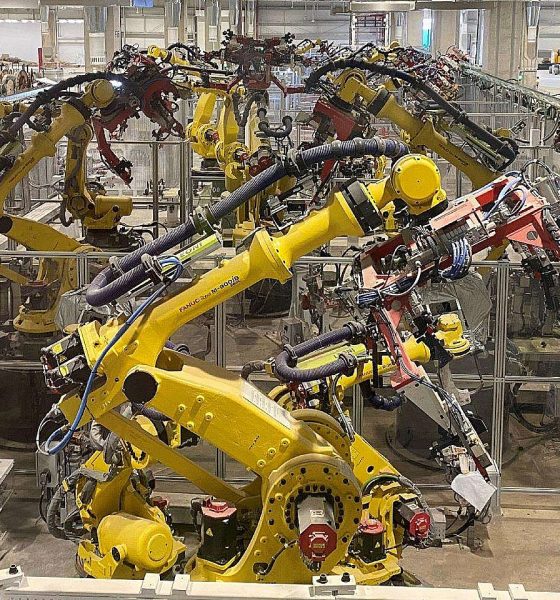Tesla’s Q3 Update Letter revealed that the electric automaker is trending toward a possible manufacturing rate of 1 million vehicles a year after a 25% increase in Quarter-over-Quarter Model 3 and Model Y production at the Fremont facility was listed in the document. Between Fremont and Giga Shanghai, Tesla is currently operating with an annual production rate of 840,000 cars a year.
Tesla’s production of both the Model 3 sedan and Model Y crossover increased from 400,000 to 500,000 vehicles annually from Q2 to Q3. The two update letters, which detail the company’s progress during two separate three-month spans, indicate manufacturing efficiency and newly installed production lines.
The company wrote:
“We have recently increased capacity of Model 3 / Model Y to 500,000 units a year. In order to do this, we restarted our second paint shop, installed the largest diecasting machine in the world, and upgraded our Model Y general assembly line. Production should reach full capacity toward the end of this year or beginning of next year.”
Tesla (TSLA) crushes Q3 earnings with record profit, accelerates global growth
The increase in production is expected, as Tesla expanded its Model Y production line at the Fremont plant in mid-July. The company filed several applications on the City’s Public Access website, which detailed planned advancements of “General Assembly 4.5,” which is designated for Tesla’s newest vehicle’s manufacturing processes.
Additionally, the installation of two die-cast machines allowed for the Model Y’s single-piece casting design, which increased safety and manufacturing efficiency.
Tesla readies Model Y Giga Press for next-level production efficiency
But the global push toward electrification for Tesla goes far beyond Northern California. In China, the company’s Giga Shanghai facility has a production capacity of 250,000 Model 3 units a year. The company detailed its advancements at the plant in the Q3 Update Letter:
“Model 3 production capacity has increased to 250,000 units a year. We reduced the price of Model 3 to 249,900 RMB after incentives, making it the lowest-price premium mid-sized sedan in China. This was enabled both by lower-cost batteries and an increased level of local procurement. As a result of this shift in cost and starting price, we recently added a third production shift to our Model 3 factory. “
Currently, the Model 3 is the only Tesla vehicle produced at the facility. However, the company plans to begin building the Model Y at Giga Shanghai by the end of 2020.
With Fremont and Shanghai producing 590,000 and 250,000 vehicles annually, Tesla is on track to reach a manufacturing rate of 1 million vehicles per year. It is possible that with Giga Shanghai’s introduction of the Model Y, the two plants could reach the million vehicle threshold together. However, Tesla has plans for two other factories that will contribute to an ever-growing annual production rate.
In Germany, Giga Berlin is quickly taking shape, and Tesla plans to begin production at this facility in 2021. The company also detailed the progress at its first European plant by saying:
“Construction of the Gigafactory in Berlin continues to progress rapidly. Buildings are under construction, and equipment move-in will start over the coming weeks. At the same time, the Giga Berlin team continues to grow. Production is expected to start in 2021.”
Finally, Tesla is also working on building another U.S.-based plant in Austin, Texas, which will introduce the Cybertruck and Semi, and also produce the Model 3 and Model Y for East Coast customers.
Tesla reported its fifth-consecutive profitable quarter, announcing revenue of $8.771 billion for the quarter, and non-GAAP earnings per share of $0.76. Additionally, Tesla posted $809M GAAP operating income, resulting in a 9.2% operating margin. The company also ended the third quarter with $331M GAAP net income and $874M non-GAAP net income (ex-SBC).

News
Tesla FSD fleet is nearing 7 billion total miles, including 2.5 billion city miles
As can be seen on Tesla’s official FSD webpage, vehicles equipped with the system have now navigated over 6.99 billion miles.

Tesla’s Full Self-Driving (Supervised) fleet is closing in on almost 7 billion total miles driven, as per data posted by the company on its official FSD webpage.
These figures hint at the massive scale of data fueling Tesla’s rapid FSD improvements, which have been quite notable as of late.
FSD mileage milestones
As can be seen on Tesla’s official FSD webpage, vehicles equipped with the system have now navigated over 6.99 billion miles. Tesla owner and avid FSD tester Whole Mars Catalog also shared a screenshot indicating that from the nearly 7 billion miles traveled by the FSD fleet, more than 2.5 billion miles were driven inside cities.
City miles are particularly valuable for complex urban scenarios like unprotected turns, pedestrian interactions, and traffic lights. This is also the difference-maker for FSD, as only complex solutions, such as Waymo’s self-driving taxis, operate similarly on inner-city streets. And even then, incidents such as the San Francisco blackouts have proven challenging for sensor-rich vehicles like Waymos.
Tesla’s data edge
Tesla has a number of advantages in the autonomous vehicle sector, one of which is the size of its fleet and the number of vehicles training FSD on real-world roads. Tesla’s nearly 7 billion FSD miles then allow the company to roll out updates that make its vehicles behave like they are being driven by experienced drivers, even if they are operating on their own.
So notable are Tesla’s improvements to FSD that NVIDIA Director of Robotics Jim Fan, after experiencing FSD v14, noted that the system is the first AI that passes what he described as a “Physical Turing Test.”
“Despite knowing exactly how robot learning works, I still find it magical watching the steering wheel turn by itself. First it feels surreal, next it becomes routine. Then, like the smartphone, taking it away actively hurts. This is how humanity gets rewired and glued to god-like technologies,” Fan wrote in a post on X.
News
Tesla starts showing how FSD will change lives in Europe
Local officials tested the system on narrow country roads and were impressed by FSD’s smooth, human-like driving, with some calling the service a game-changer for everyday life in areas that are far from urban centers.

Tesla has launched Europe’s first public shuttle service using Full Self-Driving (Supervised) in the rural Eifelkreis Bitburg-Prüm region of Germany, demonstrating how the technology can restore independence and mobility for people who struggle with limited transport options.
Local officials tested the system on narrow country roads and were impressed by FSD’s smooth, human-like driving, with some calling the service a game-changer for everyday life in areas that are far from urban centers.
Officials see real impact on rural residents
Arzfeld Mayor Johannes Kuhl and District Administrator Andreas Kruppert personally tested the Tesla shuttle service. This allowed them to see just how well FSD navigated winding lanes and rural roads confidently. Kruppert said, “Autonomous driving sounds like science fiction to many, but we simply see here that it works totally well in rural regions too.” Kuhl, for his part, also noted that FSD “feels like a very experienced driver.”
The pilot complements the area’s “Citizen Bus” program, which provides on-demand rides for elderly residents who can no longer drive themselves. Tesla Europe shared a video of a demonstration of the service, highlighting how FSD gives people their freedom back, even in places where public transport is not as prevalent.
What the Ministry for Economic Affairs and Transport says
Rhineland-Palatinate’s Minister Daniela Schmitt supported the project, praising the collaboration that made this “first of its kind in Europe” possible. As per the ministry, the rural rollout for the service shows FSD’s potential beyond major cities, and it delivers tangible benefits like grocery runs, doctor visits, and social connections for isolated residents.
“Reliable and flexible mobility is especially vital in rural areas. With the launch of a shuttle service using self-driving vehicles (FSD supervised) by Tesla in the Eifelkreis Bitburg-Prüm, an innovative pilot project is now getting underway that complements local community bus services. It is the first project of its kind in Europe.
“The result is a real gain for rural mobility: greater accessibility, more flexibility and tangible benefits for everyday life. A strong signal for innovation, cooperation and future-oriented mobility beyond urban centers,” the ministry wrote in a LinkedIn post.
News
Tesla China quietly posts Robotaxi-related job listing
Tesla China is currently seeking a Low Voltage Electrical Engineer to work on circuit board design for the company’s autonomous vehicles.

Tesla has posted a new job listing in Shanghai explicitly tied to its Robotaxi program, fueling speculation that the company is preparing to launch its dedicated autonomous ride-hailing service in China.
As noted in the listing, Tesla China is currently seeking a Low Voltage Electrical Engineer to work on circuit board design for the company’s autonomous vehicles.
Robotaxi-specific role
The listing, which was shared on social media platform X by industry watcher @tslaming, suggested that Tesla China is looking to fill the role urgently. The job listing itself specifically mentions that the person hired for the role will be working on the Low Voltage Hardware team, which would design the circuit boards that would serve as the nervous system of the Robotaxi.
Key tasks for the role, as indicated in the job listing, include collaboration with PCB layout, firmware, mechanical, program management, and validation teams, among other responsibilities. The role is based in Shanghai.
China Robotaxi launch
China represents a massive potential market for robotaxis, with its dense urban centers and supportive policies in select cities. Tesla has limited permission to roll out FSD in the country, though despite this, its vehicles have been hailed as among the best in the market when it comes to autonomous features. So far, at least, it appears that China supports Tesla’s FSD and Robotaxi rollout.
This was hinted at in November, when Tesla brought the Cybercab to the 8th China International Import Expo (CIIE) in Shanghai, marking the first time that the autonomous two-seater was brought to the Asia-Pacific region. The vehicle, despite not having a release date in China, received a significant amount of interest among the event’s attendees.










